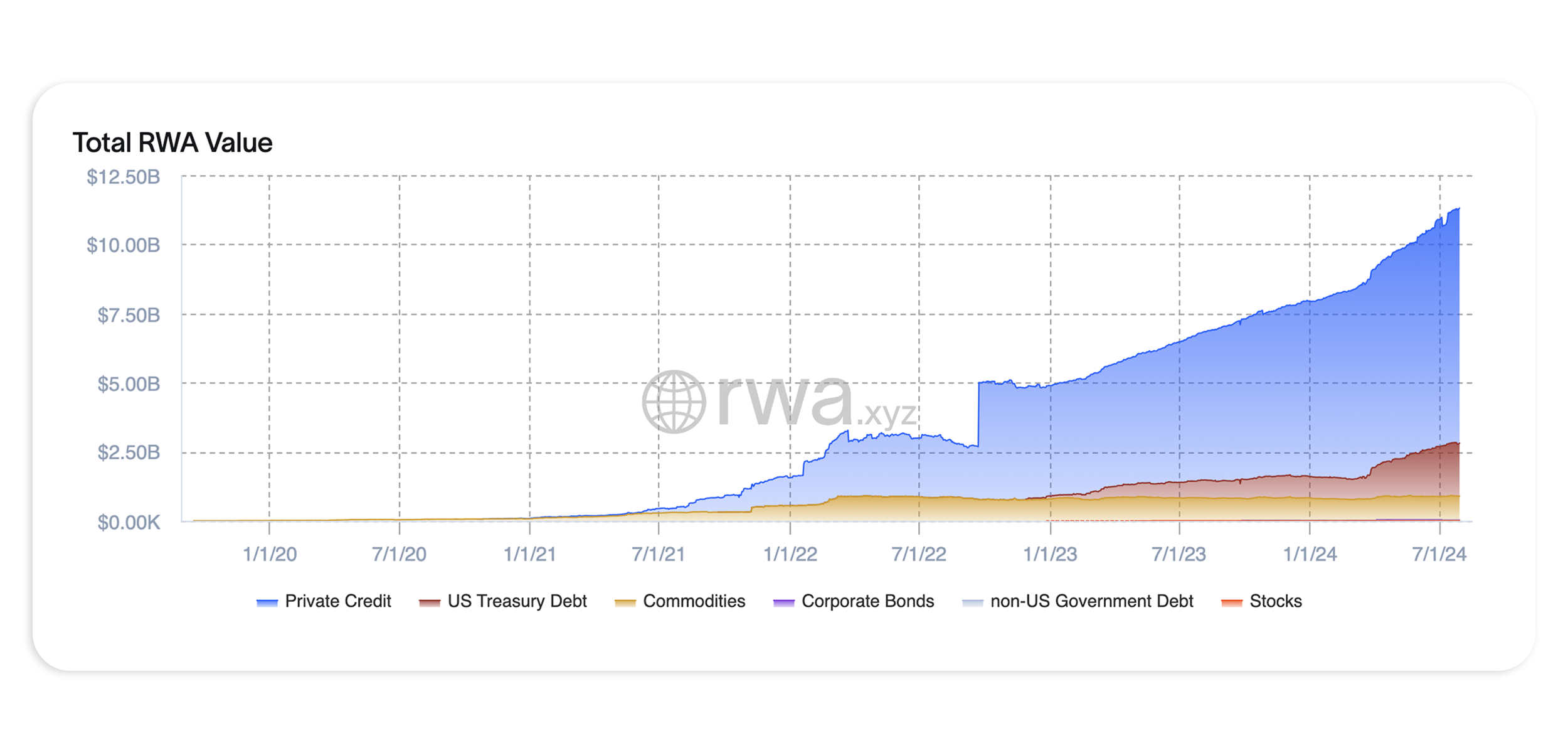Overview of Real-World Assets
 5 minutes
5 minutes

 5 minutes
5 minutes

Real-world assets (RWAs) are assets that are represented on blockchains. This is achieved through a process called ‘tokenisation’, where blockchain-based smart contracts are leveraged to create digital tokens that represent ownership or rights associated with the underlying asset.

Virtually any asset can become an RWA through this tokenisation process. The nature of these assets can be physical (e.g. real estate, fine art, precious metals), financial (e.g. equities, corporate bonds, fiat currencies) or intangible (e.g. intellectual property, insurance).
To date, the vast majority of RWA activity has centered around financial assets, with the largest ones being USD-backed stablecoins (e.g. USDC) as well as tokenised U.S. Treasuries and other cash equivalents (e.g. BlackRock’s BUIDL fund).
RWAs have the potential to unlock certain benefits that legacy financial systems cannot. Some of these benefits are described below.
Cost savings: Smart contracts can reduce the extent to which financial intermediaries are involved in the asset-management process, lowering operational costs for issuers and fees for users.
Greater transparency: Public blockchains are exceptional at maintaining a secure, immutable record of ownership and transactions. This is beneficial because it could result in more streamlined audit and compliance processes, reduced fraud, and improved trust between parties.
Enhanced market efficiency: Certain RWAs can be traded 24/7 from anywhere in the world. Also, because RWAs can be fractionalised (i.e. ownership of the underlying asset is represented by multiple tokens instead of one), more investors can gain access to assets they otherwise could not afford, such as real estate.
“We believe that blockchain technologies have the potential to reshape the investment management industry by providing greater transparency and lower operational costs for traditional financial products.”
Roger Bayston, Head of Digital Assets at Franklin Templeton

While the concept of asset securitisation and RWAs has existed for several years, adoption has been slower than many initially predicted. Below are some of the major challenges hindering the adoption of RWAs.
Regulatory uncertainty: The lack of clear legislation regarding the classification of cryptocurrencies has resulted in most RWAs not being fully accessible. Today, the vast majority of RWAs are accessible to (i) those living in certain countries and/or (ii) exclusively accredited investors.
Lack of secondary-market liquidity: Over the years, it has proven difficult to establish sufficient liquidity in the secondary markets for RWAs, creating various market inefficiencies for buyers and sellers. This is particularly challenging for RWAs tied to financial assets (e.g. public securities).
Ondo Finance (ONDO) is a platform that offers RWAs associated with financial assets, starting with cash equivalents. Its flagship offering is OUSG, the world’s first tokenised U.S. Treasuries product launched in early 2023. Ondo also offers USDY, a tokenised yield-bearing note backed by short-term U.S. Treasuries. Both products are available across multiple blockchains, including Ethereum and Solana.
Moving forward, Ondo aims to tokenise the various other types of financial assets that exist beyond cash equivalents. It is doing so by building Ondo Global Markets, which it announced in Feb. 2024, to address the ongoing lack of secondary-market liquidity that to date has limited the adoption of RWAs tied to many financial assets (e.g. public securities).
“Getting more assets to come on chain is the motivation behind the
concept we are calling Ondo Global Markets. Its most fundamental
feature: creating on chain access to any publicly listed security.”
Ian De Bode, Chief Strategy Officer at Ondo Finance
Chainlink (LINK) is the leading decentralised oracle solution in the crypto market. In recent years, its suite of services has expanded well beyond offering reliable price data to DeFi projects. One area of expansion has been RWAs and asset tokenisation.
For RWAs to continue growing, they will require essential infrastructure that can reliably provide up-to-date data about prices, user identity, collateral ratios and more. Chainlink has spent several years piloting applications of RWAs and asset tokenisation with major financial institutions.
For example, in May 2024, the Depository Trust and Clearing Corporation (DTCC), the world’s largest securities settlement system, reported on a pilot project it conducted with Chainlink and several major U.S. financial institutions (e.g. BNY Mellon, JP Morgan).
This pilot attempted to standardise the provision of net asset value (NAV) data of funds across blockchains, using Chainlink’s Cross-Chain Interoperability Protocol (CCIP). As per the DTCC’s report, “CCIP is the only cross-chain protocol that offers defense-in-depth security.”
“ANZ recently worked with Chainlink CCIP to complete a test
transaction to simulate the purchase of a tokenised asset… This
transaction involved technical integration of ANZ’s digital asset services technology stack with CCIP to realise cross-chain settlement of
tokenised assets securely and efficiently.”
Nigel Dobson, Banking Services Lead at ANZ
Real-world assets (RWAs) are assets that are represented on blockchains. Compared to legacy systems, RWAs can offer cost savings for asset managers and improved market efficiencies, benefiting all parties. While the RWA sector has been steadily growing in recent years, the rate of growth has likely been capped due to regulatory uncertainty and a lack of secondary markets. Efforts to develop clearer laws are ongoing.
